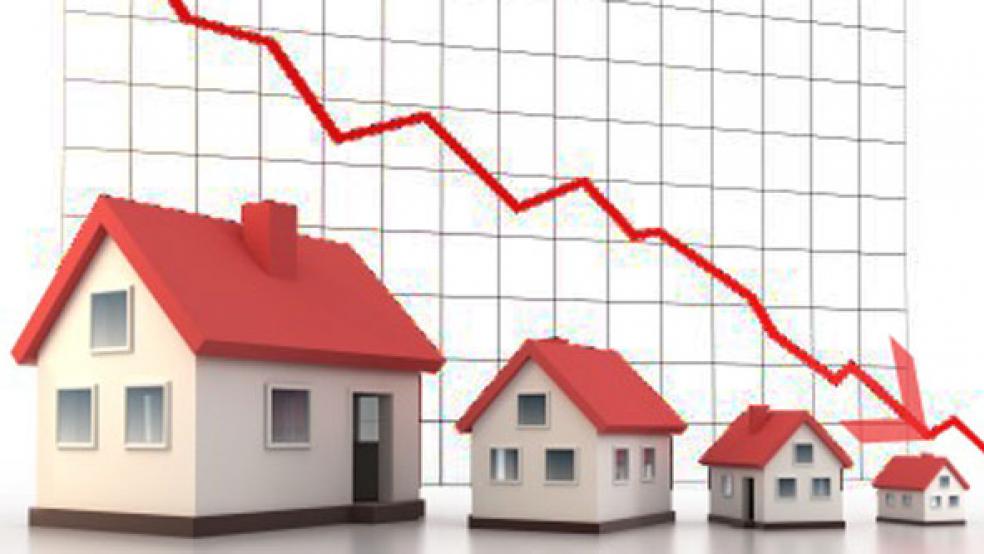For the latest theatrics in the plummeting housing market saga, the Commerce Department said on Wednesday that Americans purchased fewer new homes in 2010 than in any other year dating back to 1963 when the data was first collected. And in spite of a large spike in the sale of housing starts in December, economists say the jump was more circumstantial than emblematic of a resurgent market.
In the report, the Commerce Department estimated 321,000 new homes were sold in 2010, some 14.2 percent below the 2009 figures. If housing is weak then the economy has a harder time gaining momentum, says Celia Chen, an economist with Moody’s.
However, looking at the volatile monthly data, the housing market ended on a bit of a positive note in 2010. December new home sales jumped 17.5 percent, the highest level since April when a federal tax credit gave the market a temporary boost.
“December’s numbers are stronger and gives hope that the year-end momentum will lead to a sustained gain in home sales this year,” Chen said.
But some experts say last month’s gains were primarily driven by a tax credit that expired at the end of last year. New home buyers in California could qualify for a tax incentive worth as much as $10,000 if they signed a contract between May 1 and the end of 2010, and close the deal by Aug. 1 this year. As many as 25,810 potential homebuyers submitted applications for the tax credit as of Jan. 25, 2010, according to the California Franchise Tax Board.
“The impressive increase in new home sales in December is mainly due to the rush to beat the deadline of a tax credit in California,” said Paul Dales, an economist with Capital Economics. “Without that boost, new sales would have been broadly unchanged. New sales in California will probably fall this month, dragging down overall sales.” Dales estimated new home sales would have only increased marginally to approximately 285,000.
Changes in building codes in California also helped spur the temporary surge in new home sales, according to Moody’s and the National Association of Home Builders (NAHB). Every three years California adopts a new standard of building codes, which costs both the builders and the buyers more money, sometimes as much as $10,000, according to David Crowe, chief economist with NAHB. However, builders and buyers can skirt these costs if they submit permits in advance of the changes. The sharpest sales gains were in the western parts of the country, which saw a 70 percent increase in sales. The Midwest and the South saw modest gains with 3.2 percent and 1.8 percent, respectively. “This surge in sales, combined with fewer homes available for sale drove down the months of inventory to 6.9 from 8.4,” Chen said.
Also significant from Wednesday’s report was the inventory level of unsold homes, approximately 190,000, the lowest on record since 1968. A main cause for concern is the difficulty homebuilders face obtaining credit to build new homes. “They won’t be able answer the demand that we expect to start arriving as we go through 2011,” Crowe said.
A spokesperson with the American Bankers Association acknowledged even though access to credit has eased, “it’s still not easy to get.”
Another main constraint to a rebound in new home sales for 2011 will be competition from distressed homes, which threatens to stall a housing market recovery.
Still, home sale prices and mortgage rates at historic lows are making homes more affordable. The real estate website Trulia.com found in its Rent vs. Buy index, that it is more affordable to buy than to rent a two-bedroom home in 72 percent of the 50 largest U.S. cities.
New home sales have been in a lull for the last six months and December’s numbers signal the housing market may be moving out of it, said Crowe. Economists and housing experts are optimistic about the outlook for 2011. Moody’s has an aggressive outlook for 2011, forecasting new home sales will accelerate up to 650,000, based on expected job growth and pent up demand from home buyers.
Home buyers have delayed buying a new home due to uncertainty about employment security, as well as monitoring falling home prices and mortgage rates.
A combination of an improving labor market, an unexpected increase in consumer confidence in January, along with affordable housing will help spur demand for new homes this year. However, the unemployment rate which stands at 9.4 percent needs to drop in order for home buyers to feel confident again.
Related Links:
New US Home Sales Rise More than Forecast as West Surges (Bloomberg)
New-Home Sales Increase (Wall Street Journal)
New Homes Sales Rise Reach 329,000 in December (Market Watch)


